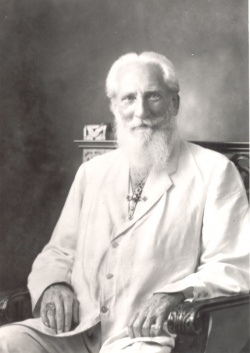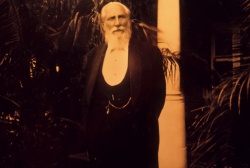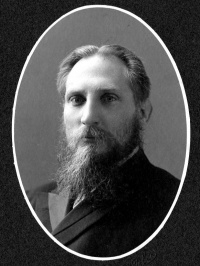Charles Webster Leadbeater: Difference between revisions
Pablo Sender (talk | contribs) No edit summary |
Pablo Sender (talk | contribs) |
||
| Line 22: | Line 22: | ||
CWL nourished, educated and trained young Krishnamurti, who gradually began to resent the discipline imposed on him. As he became a teenager and left [[Adyar (campus)|Adyar]] to live in Europe, he grew rebellious about his supposed spiritual role, and their relationship got more distant. But in 1922 this changed. | CWL nourished, educated and trained young Krishnamurti, who gradually began to resent the discipline imposed on him. As he became a teenager and left [[Adyar (campus)|Adyar]] to live in Europe, he grew rebellious about his supposed spiritual role, and their relationship got more distant. But in 1922 this changed. | ||
J. Krishnamurti arrived to Sydney in April to attend the Australian National Convention. There, he saw again CWL after | J. Krishnamurti arrived to Sydney in April to attend the Australian National Convention. There, he saw again CWL after about ten years. He wrote in a letter to Lady Emily C.W.L. was "just the same", and added: "He is much whiter in hair, just as jovial & beaming with happiness. He was very glad to see us. He took my arm & held on to it & introduced me to all with a 'voilà' in his tone. I was very glad to see him too."<ref>Mary Lutyens, ''Krishnamurti: The Years of Awakening'' (New York: Farrar, Straus and Giroux, 1975), 140.</ref> | ||
During one of the meetings at the Convention an argument ''pro'' and ''con'' CWL broke out. J. Krishnamurti, who was present, spoke out and declared that he knew Leadbeater better than most of those present, and that he could speak with some authority. As he reported later, he then declared that CWL "was one of the purest and one of the greatest men I had ever met. His clairvoyance may be doubted but not his purity."<ref>Mary Lutyens, ''Krishnamurti: The Years of Awakening'' (New York: Farrar, Straus and Giroux, 1975), 143.</ref> | During one of the meetings at the Convention an argument ''pro'' and ''con'' CWL broke out. J. Krishnamurti, who was present, spoke out and declared that he knew Leadbeater better than most of those present, and that he could speak with some authority. As he reported later, he then declared that CWL "was one of the purest and one of the greatest men I had ever met. His clairvoyance may be doubted but not his purity."<ref>Mary Lutyens, ''Krishnamurti: The Years of Awakening'' (New York: Farrar, Straus and Giroux, 1975), 143.</ref> | ||
| Line 28: | Line 28: | ||
After Kirshnamurti left Australia he began to meditate and regain his touch with the Masters, as a result of which he had a [[Jiddu Krishnamurti#Life-altering experiences|a life-altering experience]]. After this he wrote to CWL: | After Kirshnamurti left Australia he began to meditate and regain his touch with the Masters, as a result of which he had a [[Jiddu Krishnamurti#Life-altering experiences|a life-altering experience]]. After this he wrote to CWL: | ||
<blockquote>I began consciously and deliberately to destroy the wrong accumulations of the past years since I had the ''misfortune'' of leaving you. Here let me acknowledge with shame that my feelings towards you were not what they should have been. Now, they are wholly different, I think I love and respect you as mighty few people do. My love for you when we first met at Adyar has returned bringing with it the love from the past. Please ''don't'' think that I am writing mere platitudes and worn out phrases. They are not and you, my dearest brother, know me, in fact better than myself. I wish, with all my heart, that I could see you now.<ref>Mary Lutyens, ''Krishnamurti: The Years of Awakening'' (New York: Farrar, Straus and Giroux, 1975), 160.</ref></blockquote> | <blockquote>I began consciously and deliberately to destroy the wrong accumulations of the past years since I had the ''misfortune'' of leaving you. Here let me acknowledge with shame that my feelings towards you were not what they should have been. Now, they are wholly different, I think I love and respect you as mighty few people do. My love for you when we first met at Adyar has returned bringing with it the love from the past. Please ''don't'' think that I am writing mere platitudes and worn out phrases. They are not and you, my dearest brother, know me, in fact better than myself. I wish, with all my heart, that I could see you now.<ref>Mary Lutyens, ''Krishnamurti: The Years of Awakening'' (New York: Farrar, Straus and Giroux, 1975), 160.</ref></blockquote> | ||
== Liberal Catholic Church == | == Liberal Catholic Church == | ||
Revision as of 21:14, 15 May 2014
ARTICLE UNDER CONSTRUCTION
ARTICLE UNDER CONSTRUCTION
Charles Webster Leadbeater was an English Theosophist best known for his writings, his clairvoyant observations, and his involvement in the early life of Jiddu Krishnamurti.
Early life
Early Theosophical work
Colonel Olcott sent Leadbeater to Colombo, Ceylon (now Sri Lanka) to become the first principal of Ananda College. While in Ceylon, Leadbeater served as General Secretary of the Theosophical Society in that country from 1888-1889.[1]
International lecture tours
Krishnamurti
In May, 1909, C. W. Leadbeater ran into 13-year old J. Krishnamurti who was playing in the beach, and sees "the most wonderful aura he has ever seen, without a particle of selfishness". Although Theosophist and scholar Ernest Wood, who had tried to help him with his homework, considered him dim-witted, Leadbeater predicted that he would become a spiritual teacher and a great orator "much greater" than even Annie Besant.[2]
CWL nourished, educated and trained young Krishnamurti, who gradually began to resent the discipline imposed on him. As he became a teenager and left Adyar to live in Europe, he grew rebellious about his supposed spiritual role, and their relationship got more distant. But in 1922 this changed.
J. Krishnamurti arrived to Sydney in April to attend the Australian National Convention. There, he saw again CWL after about ten years. He wrote in a letter to Lady Emily C.W.L. was "just the same", and added: "He is much whiter in hair, just as jovial & beaming with happiness. He was very glad to see us. He took my arm & held on to it & introduced me to all with a 'voilà' in his tone. I was very glad to see him too."[3]
During one of the meetings at the Convention an argument pro and con CWL broke out. J. Krishnamurti, who was present, spoke out and declared that he knew Leadbeater better than most of those present, and that he could speak with some authority. As he reported later, he then declared that CWL "was one of the purest and one of the greatest men I had ever met. His clairvoyance may be doubted but not his purity."[4]
After Kirshnamurti left Australia he began to meditate and regain his touch with the Masters, as a result of which he had a a life-altering experience. After this he wrote to CWL:
I began consciously and deliberately to destroy the wrong accumulations of the past years since I had the misfortune of leaving you. Here let me acknowledge with shame that my feelings towards you were not what they should have been. Now, they are wholly different, I think I love and respect you as mighty few people do. My love for you when we first met at Adyar has returned bringing with it the love from the past. Please don't think that I am writing mere platitudes and worn out phrases. They are not and you, my dearest brother, know me, in fact better than myself. I wish, with all my heart, that I could see you now.[5]
Liberal Catholic Church
Years at The Manor
Writings
Later years
Online resources
Articles and pamphlets
- An Appreciation of C. W. Leadbeate by Geoffrey Hodson
- C. W. Leadbeater - A Great Occultist Compiled by Sandra Hodson and Mathias J. van Thiel
- C.W. Leadbeater in Retrospect By Hugh Shearman
Additional resources
Notes
- ↑ "General Secretaries". The Theosophical Year Book, 1938. (Adyar, Madras, India: Theosophical Publishing House, 1938), 152.
- ↑ Mary Lutyens, Krishnamurti: The Years of Awakening (New York: Farrar, Straus and Giroux, 1975), 21.
- ↑ Mary Lutyens, Krishnamurti: The Years of Awakening (New York: Farrar, Straus and Giroux, 1975), 140.
- ↑ Mary Lutyens, Krishnamurti: The Years of Awakening (New York: Farrar, Straus and Giroux, 1975), 143.
- ↑ Mary Lutyens, Krishnamurti: The Years of Awakening (New York: Farrar, Straus and Giroux, 1975), 160.


